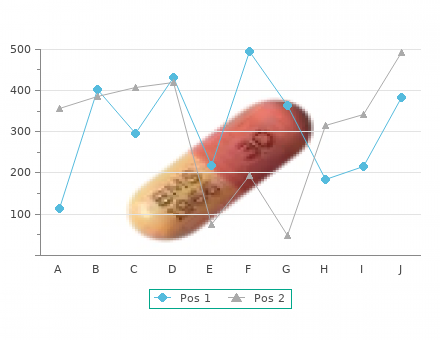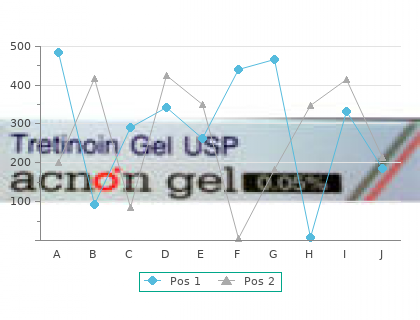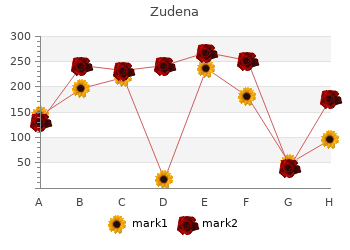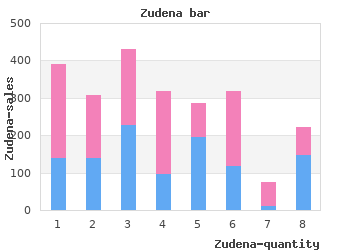Zudena
By J. Gamal. New England Institute of Technology.
Hemolytic anemia Hemolytic anemia is characterized by increased destruction of red blood cells purchase zudena 100 mg on line. Biliary obstruction This is obstruction of intrahepatic or extrahepatic bile ducts. Hepatocellular disease This is associated with failure of conjugation of bilirubin. It appears in tissues as golden brown amorphous aggregates & is identified by its staining reaction (blue 17 color) with the Prussian blue dye. Hemosiderin exists normally in small amounts within tissue macrophages of the bone marrow, liver, & spleen as physiologic iron stores. Hemosiderosis When accumulation of hemosiderin is primarily within tissue macrophages & is not associated with tissue damage, it is called hemosiderosis. Necrosis In necrosis, excess fluid enters the cell, swells it, & ruptures its membrane which kills it. After the cell has died, intracellular degradative reactions occur within a living organism. Ischemia can be caused by obstruction of arterial blood flow the most common cause, or by decreased perfusion of tissues by oxygen-carrying blood as occurs in cardiac failure, hypotension, & shock. The cell injury that results following hypoxia can be divided into early & late stages: 1. Failure of the cell membrane Na K pump, which leads to increased intracellular Na & water, which cause cellular & organelle swelling. Cellular swelling (hydropic change) is characterized by the presence of large vacuoles in the cytoplasm. It is caused by massive calcium influx & very low pH, which lead to activation of enzymes, which damage the cell membrane& organelle membranes. Free radical-induced injury Free radical is any molecule with a single unpaired electron in the outer orbital. Cell membrane damage Direct cell membrane damage as in extremes of temprature, toxins, or viruses, or indirect cell membrane damage as in the case of hypoxia can lead to cell death by disrupting the homeostasis of the cell. Increased intracellular calcium level Increased intracellular calcium level is a common pathway via which different causes of cell injury operate. For example, the cell membrane damage leads to increased intracellular calcium level. The increased cytosolic calcium, in turn, activates enzymes in the presence of low pH. Coagulative necrosis Cogulative necrosis most often results from sudden interruption of blood supply to an organ, especially to the heart. It is, in early stages, characterized by general preservation of tissue architecture. It is marked by the following nuclear changes: Pyknosis (which is chromatin clumping & shrinking with increased basophilia), karyorrhexis (fragmentation of chromatin), & karyolysis (fading of the chromatin material). Liquefactive necrosis Liquefactive necrosis is characterized by digestion of tissue. Fat necrosis Fat necrosis can be caused by trauma to tissue with high fat content, such as the breast or it can also be caused by acute hemorrhagic pancreatitis in which pancreatic enzymes diffuse into the inflamed pancreatic tissue & digest it. The fatty acids released from the digestion form calcium salts (soap formation or dystrophic calcification). In addition, the elastase enzyme digests the blood vessels & cause the hemorrhage inside the pancreas, hence the name hemorrhagic pancreatitis. Caseous necrosis Caseous necrosis has a cheese-like (caseous, white) appearance to the naked eye. Gangrenous necrosis This is due to vascular occlusion & most often affects the lower extremities & the bowel. It is called wet gangrene if it is complicated by bacterial infection which leads to superimposed liquefactive necrosis. Whereas it is called dry gangrene if there is only coagulative necrosis without liquefactive necrosis. Apoptosis usually occurs as a physiologic process for removal of cells during embryogenesis, menstruation, etc It can also be seen in pathological conditions caused by mild injurious agents. Metastatic calcification This is caused by hypercalcemia, resulting from hyperparathyroidism, milk-alkali syndrome, sarcoidosis etc 2. Inflammation is fundamentally destined to localize and eliminate the causative agent and to limit tissue injury. Thus, inflammation is a physiologic (protective) response to injury, an observation made by Sir John Hunter in 1794 concluded: inflammation is itself not to be considered as a disease but as a salutary operation consequent either to some violence or to some diseases.


The pathogenic efect of IgG4 autoantibodies in en- demic pemphigus foliaceus (fogo selvagem) generic zudena 100mg without prescription. Antigen-specifc activation, tolerization, and reactivation of the interleukin 4 pathway in vivo. Down-regulation of T cell receptors on self-reactive T cells as a novel mechanism for extrathymic tolerance induction. Dendritic cells: from ignored cells to major play- 1 ers in T-cell-mediated immunity. Chronic intestinal infammation: an unexpected outcome in cytokine or T cell receptor mutant mice. Lichen ruber planus following the administration of human anti-hepatitis B virus immunoglobulins [letter]. Identifcation of a human helper T cell population that has abundant production of interleukin 22 and is distinct from T(H)-17, T(H)1 and T(H)2 cells. T lymphocytes derived from skin lesions of patients with psoriasis vulgaris express a novel cytokine pattern that is dis- tinct from that of T helper type 1 and T helper type 2 cells. Coexpres- sion of B7-1 and viral (self) transgenes in pancreatic beta cells can break peripheral ignorance and lead to spontaneous autoimmune diabetes. Extrathymic tolerance of mature T cells: clonal elimina- tion as a consequence of immunity. Specifc low-afnity recognition of major histocompatibility complex plus peptide by soluble T-cell receptor. Distinct regulation of lymphokine production is found in fresh versus in vitro primed murine helper T cells. Molecular mimicry in T cell-mediated autoim- munity: viral peptides activate human T cell clones specifc for myelin basic protein. Immunotherapy in neuroimmuno- logic diseases (London: Martin Dunitz Ltd) Zimmermann, S. CpG oligodeoxynucleotides trigger protective and curative T1 responses in lethal murine leishmaniasis. Tese recommendations will contribute to improve the comparability of diagnostic procedures and are intended to aid the interpretation of fndings, independent of the lab- oratory in which the tests are performed. The recommendations were developed in close collaboration with clinical and laboratory scientists with the focus to improve diagnostic procedures for autoimmune diseases (Sack et al. The cells have been found to be heterogeneous in their morphology, antigen expression and cell division behavior. Certain criteria are important for the judgment of the cells quality and can be heavily infuenced in the production process by cell culture conditions, cell preparation, microscope slide preparation, fxation and the processing instructions given. Furthermore, only standardized procedures make possible longitudinal measurements and comparison of results from dif- ferent laboratories. Batch monitoring requires the use of one negative serum and at least three positive serum samples with diferent fuorescence patterns resulting from defned antibody reactivity (e. In immunofuorescence laboratories it is especially im- portant to ensure low levels of dust. The microscopy room must be large enough to al- low two people to work simultaneously and must be adequately ventilated. Considerable amounts of heat can be produced, especially when microscopes with high-pressure mer- cury lamps are used. A network connection for laboratory computers simplifes working procedures and documentation. Processing of Samples Pre-analytic procedures are not critical for detection of autoantibodies. Hemolytic, lipemic, and icteric sera should be recorded in the protocol, as they may infuence the test system. Deviations from incubation times, dilutions, or bufering systems can infuence the test results when the microscope slides are evaluated and must therefore be validated in the laboratory. When microscope slides from diferent manufacturers are used, it is nec- essary to ensure that the corresponding test components are used in each case. Bufer sys- tems and conjugate concentrations, in particular, are usually adjusted for the relevant sub- strates on the microscope slides. It is also necessary to be aware of the expiry date and the correct storage method for each of the reagents used. With conjugate, in particular, a de- crease in intensity is otherwise to be expected, which can lead to a lower titer of the au- toantibody of interest. The volumes of serum and conjugate to be pipetted or dripped onto the appropriate application sites are ofen not clearly defned. It is necessary to ensure that the whole application site is covered with serum / conjugate, but an application site should not be allowed to over- fow because this immediately puts the next application site at risk of contamination. The individual incubation stages should be carried out in a humid- ity chamber to prevent the sample from desiccation, which would signifcantly reduce the sample volume per application site.


Firstly buy zudena 100 mg on-line, we will discuss whether lynx populations should be considered as a single management unit based on the existing knowledge on the genetic and demographic history of the species. Secondly, we will evaluate the genetic status of the captive Iberian lynx population as of mid- 2008. Finally, we will explore alternative strategies and discuss the role that genetic markers may play in the genetic management of this captive population. IdentIfIc atIon o f m a n a g e m e n t u n I t s : t o m I x o R n o t t o m I x In structured populations, a frst important decision is whether the different population segments should be combined and managed as a single unit or managed separately. Mixing is the best option when genetic differentiation arises as a consequence of genetic drift acting independently in recently isolated and declining populations. In this situation mixing would revert the accumulated inbreeding and maximize the potential genetic diversity of the captive stock. GeneTic d i v e r s i T y parameTers esTimaTed w i T h microsaTelliTe m a r k e r s f o r ib e r i a n ly n x a n d several oTher felid s p ec i e s. Th e few e x a m p l e s o f p o p u l aT i o n s w i T h levels o f GeneTic d i v e r s i T y similar To o r l o w e r T h a n ib e r i a n ly n x a r e h i G h l i G h T e d. The decision to mix or not to mix is, therefore, largely based on the direct evaluation of the existence of adaptive divergences or on the evaluation of the opportunities for such divergences to have arisen in view of the evolutionary and demographic history of the species. For this purpose, the analysis of genetic patterns for molecular makers might be extremely useful. Although both populations are the consequence of a common process of decline and fragmentation, they have slightly different recent demographic histories. Doana is a peripheral population that became effectively isolated from the rest of the species distribution probably more than fve decades ago, and has remained isolated and at a census size of around ffty since then. Under this demographic history, the action of genetic drift may have resulted in a pattern of low genetic diversity and high inbreeding within populations and high genetic differentiation between them, although the magnitude of these changes is diffcult to predict without precise estimates of demographic parameters over time. The two main findings are that genetic diversity is globally low, but lower in Doana than in Sierra Morena, and that these two populations show a high level of genetic differentiation. Mitochondrial diversity is extremely low in the Iberian lynx, with only two haplotypes observed which differ in one single position. However, 91 our previous study detected the presence of the Doana haplotype in a museum specimen from Sierra Morena, and also showed the occurrence of a third now extinct haplotype in Western Sierra Morena (province of Huelva) (Johnson et al. These results with mitochondrial DnA provide direct evidence for diversity losses in recent times due to drift in the small remnant populations and to the extinction of differentiated populations. Iberian lynx nuclear microsatellite diversity levels are also globally low, both in terms of heterozygosity and allelic diversity. On the contrary, some extreme examples of small isolated populations like the Gir forest lions and the Florida panther (before the successful translocation of pumas from Texas) do seem to harbour lower diversity than the Iberian lynx (Table 1). Interspecific microsatellite diversity comparisons must be interpreted with care because of the possible ascertainment bias, but they actually suggest lower genetic diversity in the Iberian lynx than in closely related populations/species with similar life history. Moreover, microsatellite heterozygosity and allelic diversity are 33% lower in Doana than in Sierra Morena. A high level of genetic differentiation is observed between Doana and Sierra Morena populations, i. As expected from the known demographic history of the species, genetic patterns found in the Iberian lynx population could have been shaped by the predominant action of genetic drift in recent times, according to size and time since isolation of each population. Accordingly, the strong differentiation found between Doana and Sierra Morena populations should be mainly due to random allele frequency fuctuations occurring in each fi G u r e 1. Moreover, low levels of current genetic diversity are probably the consequence of a steep and rapid loss in recent times, especially in Doana, where the loss might have reached over 33% in magnitude. Furthermore, an effective size like that estimated for Doana could retrospectively explain the loss of 33% heterozygosity from an ancestral diversity similar to that currently present in Sierra Morena in less than ten generations (50 years). Under such scenario, diversity losses may be equated to inbreeding accumulation, so that a 33% diversity reduction in Doana would refect a population inbreeding coeffcient for Doana well over that expected for full-sibling matings. Such high inbreeding values are often associated to a high frequency of genetic disorders, low fertility and other negative effects, as illustrated by the notorious case of the Florida panther (Roelke et al. A high incidence of glomerulonefritis and lymphoid depletion has been reported for Iberian lynx (Jimnez et al. Establishing that these and any other observed defciencies and abnormalities in Iberian lynx are due to inbreeding depression or genetic depauperation will not be easy to proof, but this possibility must be seriously considered in view of the observed genetic patterns and the recent demographic history of the species. A recent study reported morphometric differentiation between Iberian lynx populations, but also demonstrated temporal morphological changes within Doana. The potential for dispersal and gene fow in the species is probably high, as in other lynx species, although it has been shown to be strongly affected by habitat matrix (Revilla et al. The anecdotal case of an animal from Doana that made its way back after being liberated in Andjar (Eastern Sierra Morena) illustrates the potential for long distance movements in the species.
10 of 10 - Review by J. Gamal
Votes: 181 votes
Total customer reviews: 181

